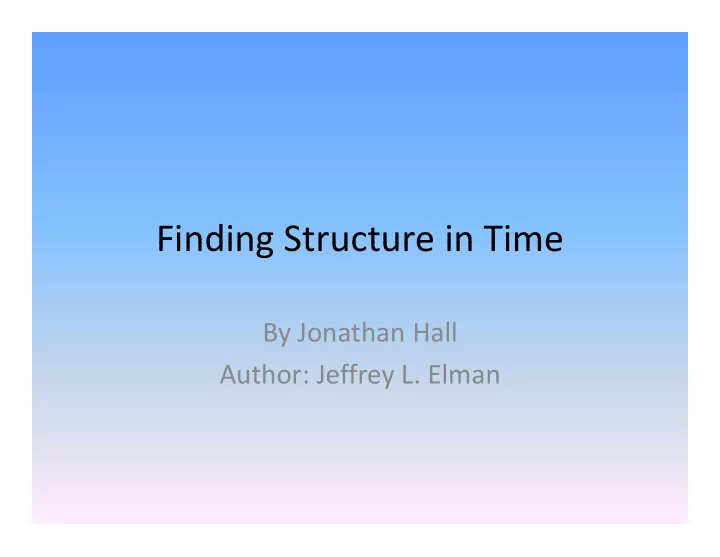

Finding Structure in Time Finding Structure in Time By Jonathan Hall Author: Jeffrey L. Elman Author: Jeffrey L. Elman
Contents Contents • Problem Problem • Algorithm • Results l • Conclusion
Problem Problem • Speech research Speech research • Usual MLP takes all input at once and returns output all at once output all at once • Speech needs temporal ordering
Past solutions to problem Past solutions to problem • Usual approach: sequential representation of Usua app oac : seque t a ep ese tat o o events – [0 1 1 1 0 0 0 0 0] – [0 0 0 1 1 1 0 0 0] • Biological Implications – How to express parallel computations in terms of human brain? • Not all input vectors same length • Not all input vectors same length – Example: translating user speech into text • Applications: prediction problems • Applications: prediction problems
Solution to Problem Solution to Problem • Variable length input Variable length input • Analyze batches of events • Dynamic system i • Remember past events
Algorithm Algorithm • Solution: give network memory with a Solution: give network memory with a recurrent network
Recurrent Networks Overview Recurrent Networks Overview • Has a directed cycle Has a directed cycle • Hopfield is a symmetric recurrent network • Good for: learning grammar speech recognition and Good for: learning grammar, speech recognition, and music composition
Author’s Network Author s Network • Why did author use network on left and not Why did author use network on left and not the one on the right?
Results Contents Results Contents • XOR XOR • Letter Sequence • Words d • Sentences
XOR XOR • Problem setup: Problem setup: – Input: 2 random bits, 3 rd bit is XOR of previous 2 bits bits – Goal: predict next bit – Example Input: 1 0 1 0 0 0 0 1 1 1 1 0 1 0 1 – Example Input: 1 0 1 0 0 0 0 1 1 1 1 0 1 0 1 …
XOR Results XOR Results
Letter Sequence Letter Sequence • Problem setup: Problem setup: – Input: Random consonants (b,d,g), then random consonants replaced with: b ‐ >ba d ‐ >dii g ‐ >guuu consonants replaced with: b >ba, d >dii, g >guuu – Each letter given unique 1x6 vector – Goal: predict next letter – Goal: predict next letter
Letter Sequence Results Letter Sequence Results
Words Words • Problem Setup: Problem Setup: – Input: String of sentences with no breaks between words or sentences words or sentences – Goal: predict next letter of sequence
Words Results Words Results
Sentence Setup Sentence Setup • A large number of simple sentences were A large number of simple sentences were randomly produced • Each word was vectorized • Each word was vectorized • No breaks in between sentences • Goal: predict the next word
Sentences Sentences
Sentences: quality measurement Sentences: quality measurement • Can’t use word ‐ by ‐ word RSS Can t use word by word RSS – Error: 0.88 • Solution use RSS for categories of words • Solution: use RSS for categories of words – Error: 0.053 • How did the network do this?
Sentence Classification Sentence Classification
Conclusion Conclusion • Some problems are different when expressed Some problems are different when expressed as temporal events. • RSS can be used to analyze the temporal RSS can be used to analyze the temporal structure. • Length of sequential dependencies doesn’t Length of sequential dependencies doesn t always worsen performance. • Representation of time and memory is task ‐ Representation of time and memory is task dependant. • Representations can be structured. Representations can be structured.
The End
Recommend
More recommend